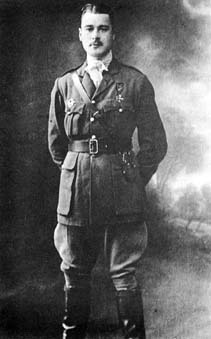Born on 19 Nov 1891 in Chicago, Illinois. He attended the New Trier High School in Winnetka, Mercersberg Academy in Pennsylvania and then entered the University of Virginia. He went to France in June 1916 and passed through the flying schools at Buc, Juvisy, Avord, Cazeaux, Pau, and Plessis-Belleville. At Juvisy he was the first American to graduate and stood highest in scholastic ability. He was assigned as a pilot to the French Lafayette Escardrille and began daily expeditions over Germany on May 30, 1917. Once his Nieuport 17 C.1 lost a wing at three thousand feet, and he was able to safely land the bi-plane. He was known for being reckless, and had a reputation for being a nuisance in the air, especially during patrols when he would maddeningly get as close as he could to others in formation until he had to be waved off. Even then, he would come right back, annoying some so much that they could not concentrate on flying. No amount of pre-flight counseling or threatening could deter him, and he would do it every flight. Eventually, Campbell took it too far one day and almost caused a serious incident. He was on patrol with Lieutenant Maison Rouge and decided to top his usual antics. He proceed to fly directly over Maison Rouge’s aircraft, bringing the wheels and fixed landing gear dangerously close to Maison Rouge’s upper wing, in an apparent attempt to bounce up and down on the latter’s aircraft. To Maison Rouge’s bewilderment, and to Campbell’s surprise, he went too far and managed to get his wheels firmly stuck into the fabric of Maison Rouge’s upper wing. The unfunny antic became much worse as both realized they were stuck fast together; all attempts to pull away from either aircraft failed to work. Since the pilots could not see each other they could not communicate and there was no recourse available to them since aviators at this time did not carry parachutes. Finally, in a desperate attempt, Campbell pulled his aircraft up with brute force and ripped away from Maison Rouge’s plane, tearing apart his upper wing. Maison Rouge, the second-in-command, was livid; he was able to land his plane but it would have to be junked. Campbell was killed in an engagement with three German airplanes on the western front north of Soissons, not far from Pargny, on October 1, 1917.

PRIVATE CITIZENS SUPPORTING AMERICA'S HERITAGE
American
War Memorials Overseas, Inc.
War Memorials Overseas, Inc.
Campbell Andrew Courtney, Jr.
Name:
Andrew Courtney, Jr. Campbell
Rank:
Sergeant
Serial Number:
Unit:
Lafayette Escadrille
Date of Death:
1917-10-01
State:
Illinois
Cemetery:
Lafayette Escadrille Memorial, Marnes la Coqu
Plot:
Row:
Grave:
Decoration:
Croix de Guerre with the gold star
Comments:
